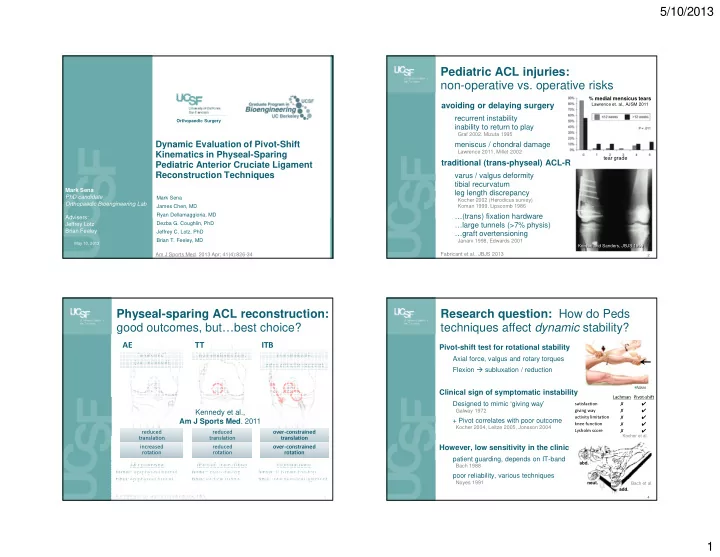

5/10/2013 Pediatric ACL injuries: non-operative vs. operative risks % medial mensicus tears avoiding or delaying surgery Lawrence et. al., AJSM 2011 recurrent instability Orthopaedic Surgery inability to return to play Graf 2002, Mizuta 1995 Dynamic Evaluation of Pivot-Shift meniscus / chondral damage Lawrence 2011, Millet 2002 Kinematics in Physeal-Sparing tear grade traditional (trans-physeal) ACL-R Pediatric Anterior Cruciate Ligament Reconstruction Techniques varus / valgus deformity tibial recurvatum Mark Sena leg length discrepancy PhD candidate Mark Sena Kocher 2002 (Herodicus survey) Orthopaedic Bioengineering Lab James Chen, MD Koman 1999, Lipscomb 1986 Ryan Dellamaggioria, MD …(trans) fixation hardware Advisers: Jeffrey Lotz Dezba G. Coughlin, PhD …large tunnels (>7% physis) Brian Feeley Jeffrey C. Lotz, PhD …graft overtensioning Brian T. Feeley, MD Janarv 1998, Edwards 2001 May 10, 2013 Koman and Sanders, JBJS 1999 Koman and Sanders, JBJS 1999 Am J Sports Med. 2013 Apr; 41(4):826-34 Fabricant et al., JBJS 2013 2 Physeal-sparing ACL reconstruction: Research question: How do Peds techniques affect dynamic stability? good outcomes, but…best choice? Pivot-shift test for rotational stability AE TT ITB “anatomic” “anatomic” non-anatomic fem. non-anatomic fem. non-anatomic non-anatomic Axial force, valgus and rotary torques (but technical) (but technical) extra-articular restraint extra-articular restraint Flexion � subluxation / reduction Clinical sign of symptomatic instability ✗ ✔ Lachman Pivot-shift ✗ ✔ Designed to mimic ‘giving way’ satisfaction ✗ ✔ Kennedy et al., Galway 1972 giving way ✗ ✔ activity limitation Am J Sports Med . 2011 + Pivot correlates with poor outcome ✗ ✔ knee function Kocher 2004, Leitze 2005, Jonsson 2004 Lysholm score reduced reduced reduced reduced over-constrained over-constrained Kocher et al. translation translation translation translation translation translation However, low sensitivity in the clinic increased increased reduced reduced over-constrained over-constrained rotation rotation rotation rotation rotation rotation patient guarding, depends on IT-band abd. Bach 1988 All Epiphyseal (Partial) Trans-Tibial Iliotibial Band femur : epiphyseal tunnel femur : over-the-top femur : ITB over-the-top poor reliability, various techniques tibia : epiphyseal tunnel tibia : vertical tunnel tibia : intermeniscal ligament Noyes 1991 neut. Bach et al. add. Illustrations by Rosanna Wustrack, MD. 3 4 1
5/10/2013 Pivot-shift: Pivot-shift: challenging in challenging in the laboratory the laboratory fair fair good poor good poor manual + manual + C.P.M. + robot + valgus & desired characteristics quantitative desired characteristics quantitative valgus load cell ITB weights reliable reliable quantitative quantitative known loads known loads dynamic dynamic accessible accessible Lopomo et al. Lopomo et al. Musahl et al. Kanamori et al. Markolf et al. Hypothesis: The AE technique best MPSD Experimental Design: restores native pivot-shift kinematics ACL intact, transected, reconstructed Optotrak constant-tension spring constant-tension spring M echanical P ivot- S hift D evice M echanical P ivot- S hift D evice digitizing optical markers probe PC ex-fix force length external fixator (Synthes) 6 knees, 5 conditions attach spring to tibia / femur intact, ACL-transected AE, TT, ITB (randomized) Optotrak™ motion capture …as determined by four outcome variables measure joint motion position spring endpoints measure spring position Anterior Displacement (AD) [mm] femur: antero-lateral Internal Rotation (IR) [deg] load cell (not shown) tibia: postero-lateral Posterior Translational Velocity (PTV) [mm/s] measure forces / moments External Rotational Velocity (ERV) [deg/s] perform test per condition spring (constant tension) …as determined by a “Knee Stability Index” passive flexion (baseline) supplies forces / moments flexion with device (3x) combines AD, IR, PTV, ERV into a single value (KSI) 7 8 2
5/10/2013 Anterior Displacement (AD) Posterior Translation Velocity (PTV) Internal Rotation (IR) External Rotational Velocity (ERV) AD * Intact PTV ** ** Deficient 12 80 TT 70 10 ITB 60 AE 8 50 ∆ d v 40 6 30 4 20 2 10 0 0 IR Intact * ERV ** n.d. ** Deficient 25 200 TT ∆θ ITB 20 160 AE 15 120 80 10 ω 40 5 0 0 * p<0.05 * p<0.05 9 10 Knee Stability Index (KSI): In summary… ‘most’ deficient 100 All techniques improved stability metrics deficient AD reduced deficient values by 18-78% PTV logistic logistic KSI only TT did not significantly reduce ERV IR regression regression ERV Iliotibial Band (ITB) reconstruction intact 0 ‘most’ intact over-constrained AD (-52%) and IR (-38%) KSI = 4.0 AD’ + 2.5 PTV’ - 2.3 IR’ - 0.3 ERV’ KSI (0.8) Partial Trans-Tibial (TT) reconstruction 100 * 80 best restored AD (5%) and IR (-6%) 60 highest KSI (13.3) KSI 40 All Epiphyseal (AE) reconstruction 20 best restored PTV (-9%) and ERV (1%) 0 -20 lowest KSI (-4.0) Deficient TT ITB AE * p<0.05 11 12 3
5/10/2013 In summary… Key references and Acknowledgements Fabricant et al., J Bone Joint Surg Am. 2013 Limitations Lawrence et al., Am J Sports Med . 2011 Adult specimens for Peds techniques Kocher et al., J Pediatr Orthop . 2002 Koman and Sanders, J Bone Joint Surg Am , 1999 Time zero study Kennedy et al., Am J Sports Med . 2011 MPSD requires (gentle) manual flexion MPSD not yet validated by others Galway et al., J. Bone Joint Surg. 1972 Kocher et al., Am J Sports Med. 2004 Noyes et al., Am J Sports Med .1991 Conclusions Lopomo et al., Knee Surg Sports Traumatol Arthrosc 2013 Operative treatment � good outcomes Musahl et al., Knee Surg Sports Traumatol Arthrosc . 2010 Kinematics depend on technique Kanamori et al, Arthroscopy . 2000 Markolf et al., J Bone Joint Surg Am . 2008 ITB extra-articular constraint … further study AE (most anatomic) improved dynamic stability This material is based on work supported by the National Science Foundation Graduate Research Fellowship (Sena, MP) 13 MPSD Device Design: continuous flexion, prescribed loads 60 tibial moment (N•m) 10 axial compression (40-50 N) valgus torque (6-8 N • m) tibial force (N) 8 40 6 4 20 2 0 0 0 20 40 60 0 20 40 60 flexion angle (deg) flexion angle (deg) 15 4
Recommend
More recommend